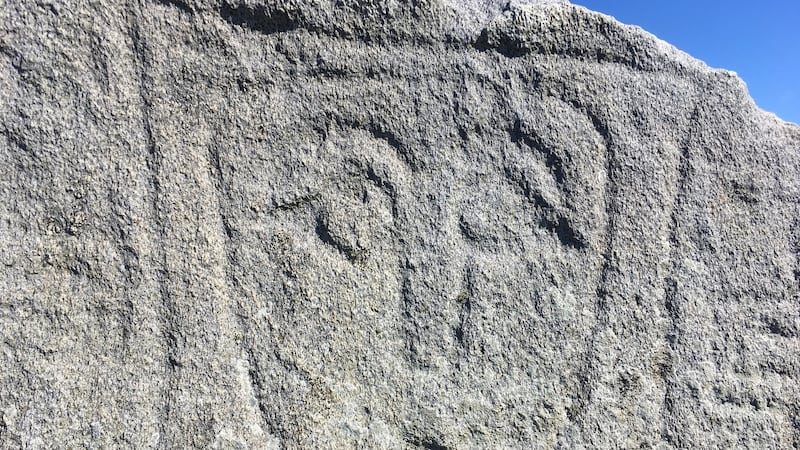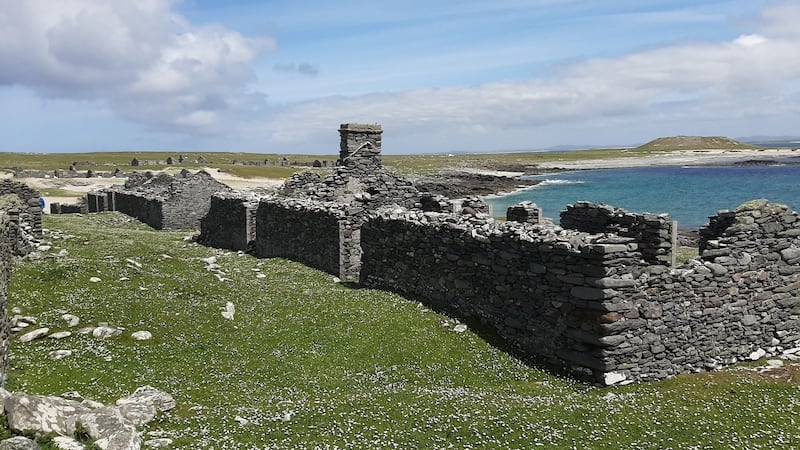It’s wild.
Northwest Mayo is the most remote place in Ireland. It contains the largest stretch of land uncrossed by a road, as well as the second largest.
“There’s something about it,” explains Barry Murphy, whose boutique walking tours have explored the region since the mid-2000s. “It’s ridiculously under-populated. Ridiculously under-exploited by tourism.”
For me, an obsessive lover of Mayo and her islands for a good 30 years, the trip to Blacksod Bay to take one of Murphy’s tours of North Iniskea Island was a step beyond.
Here my beloved Achill is the jaw-dropping back-drop: "These evenings when gradually cliffs and mountains become more and more unreal, from blue turn slowly to incredible pink hues, shades of dying embers where redness can be seen beneath silver ashes," wrote the archaeologist Francoise Henry, who excavated the monastic remains on the North Iniskea from the 1930s to the 1950s.
The North and South Iniskea Islands, uninhabited since the late 1930s, are what Murphy calls "the Nirvana" of north Mayo experiences, after "the prologue" of Belmullet and Blacksod.

It's hard to get out there. Up to 50 per cent of the time, Murphy's trips to the islands are cancelled (and fully refunded) on the word of the boatman, usually Jed Keane whose family is from South Iniskea.
Of course, that only adds to the allure. Those pictures of ruined village houses standing in a semi-circle on a white sand beach... The curiosity of the Norwegian whaling station which operated on the South Island between 1908 and 1914 ... The sense that beyond the shores of Blacksod and Achill lay a kind of ghost island, a kind of Atlantis.
The English writer TH White, famous for the Arthurian legend The Once and Future King, made a case that the Iniskeas were where Tír na nÓg really was. Tír na nÓg exists only in the imagination. But as I finally left Blacksod pier for North Iniskea on a Blacksod Sea Safaris craft on a pet of a day, and Inishglora, the last resting place of the Children of Lir, was pointed out, I did feel I was travelling into the land of myth.
North Iniskea is famous for its significant “monastic city”, centred on the 6th to 10th century Church of St Colomba. Murphy interpreted the astonishing mounds of sand, shells, bones and stones known as the Bailey Mor, the Bailey Beag and the Bailey Doigte (the big, the small and the burned habitation): these giant cairns are the remains of beehive monastic houses which collapsed and filled with sand.

New life is hatching there now as evidenced by the shrieks of birds as we approached and the whack Murphy got from a black-backed gull.
Within the “city” is a midden of shells left behind by the monks’ industry, extracting valuable purple dye from the shells of dog whelks. Iniskea dye travelled as far as Constantinople. Maybe it swathed a Byzantine king.
Then suddenly, the light shifts and an image of Christ appears on a slab which probably dates from the late 7th or early 8th century. He is supping vinegar from a clearly drawn cup and he is smiling: this is the risen Christ.
It’s as if an unnamed artist is speaking to us across 12 or 13 centuries through this carefully realised vision from the Gospel.

While there are signs of habitation from the Bronze Age on the Inishkeas, there is little record of any habitation from the 12th to the 18th century. In the 19th century there were more than 200 people on the islands, which both had a school.
There was no functioning church but the rosary was said on alternate islands on Sunday nights.
Unvisited by organised religion, it is not surprising that these weather-throttled islands had some of their own. The famous “Godstone” or “Naomh/óg” was immortalised by TH White in his memoir of his time on the islands, The Godstone and the Blackymore.
The speculations on the so-called “naomhóg” – the “little saint” – are fascinating. It seems to have been a ceramic early Christian remnant which was broken and then sewn a new suit of clothes every year to keep it together. It resided in the best house on the South Island where it guarded against fire and pestilence until it was thrown into the sea by a disgruntled priest. He was dead within the year.
Why did the islanders leave?
Stupid question, maybe. The Cleggan Disaster of 1927 took 10 of their best men. The land had been exhausted by the spreading of seaweed.
It seems they were tired of their medieval existence and keen to get their hands on the extra land being offered to them on the mainland, while their title to their island land remained intact. One man lives on the North Island while there is a holiday house on the South Island.
“We have gone but there will be another race,” an evacuated islander told TH White in the 1940s. It is likely this will be a race of tourists.








